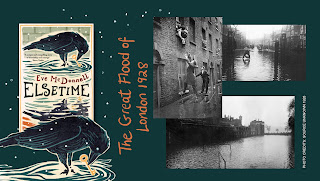Hi, I was absolutely delighted to be asked to make a film about mudlarking* for the Time Tunnellers.
If you don’t know, mudlarking is searching the Thames foreshore at low tide to see what historical treasures you can find, and you need a permit from the Port of London Authority to do it. I’m always more than happy to talk about mudlarking, so I set off on a chilly late winter’s day to see what the Thames would give me.
The tide wasn’t particularly low, but the Thames was generous, as she usually is. My favourite finds were a tiny 17th century pipe bowl and a lovely nugget of fool’s gold. Someone suggested that I break it open to see what it’s like inside, but I think it’s beautiful as it is. What do you think?? What would you do?
One of Kate's mudlarking finds
I didn’t come across my dream find: a bellarmine jug or
witch bottle. They were used in the 17th century to ward off
witchcraft. Superstitious people filled them with nail clippings, hair, red
thread and even urine to counteract witches’ spells. Often they would be buried
under the doorway of a house, or beneath the fireplace. Others were simply used
to transport alcohol and thrown into the Thames when empty.
I did find the handle of one, and also the eye from the representation of an angry-looking man. These were applied to the front of bellarmine bottles. I dream about finding a whole one and if I ever do, I’ll be shouting about it from the rooftops.
the original mudlarkers were poor children.
My first Mudlark Mystery, The Grinning Throat, features a witch bottle and on the front cover, Edie Lighterman, one of my protagonists, is shown holding one. That will have to do until I find a real one. Watch this space…
'My first thought is that it’s a pig that someone has lost to the river. Perhaps it fell off one of the barges that choke up the Thames. They’re a constant feature, toiling up and down, day and night, giving off black smoke that clings to the water.'
Joe (15) and Edie (13) are orphans living in Victorian London. Forever worried that they will be sent to the dreaded workhouse, they scratch out a living the best way they can by mudlarking on the foreshore of the River Thames and selling their finds to the notorious Hempson. One day they discover something macabre, and it will change their lives forever.
The Grinning Throat is the first in the trilogy of The Mudlark Mysteries. Written by award winning author, Kate Wiseman, it is historical fiction at its best. Suitable for readers from age 9 and upwards.
The Grinning Throat has been longlisted in the historical Association's Young Quills 2024 award.
You can buy copies online HERE.
Find out more about mudlarking and Kate's other books at Katewiseman.co.uk
*Mudlarkers in London must have a Thames Foreshore Permit which can be obtained from the Port of London Authority. All objects which are three hundred years old or more must be reported to the Museum of London. Mudlarks arrange regular appointments with a Finds Liaison Officer who records the artefacts on the Portable Antiquities Scheme managed by the British Museum.











